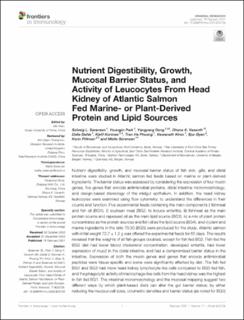| dc.contributor.author | Sørensen, Solveig Lysfjord | |
| dc.contributor.author | Park, Youngjin | |
| dc.contributor.author | Gong, Yangyang | |
| dc.contributor.author | Vasanth, Ghana Kalerammana | |
| dc.contributor.author | Dahle, Dalia | |
| dc.contributor.author | Korsnes, Kjetil | |
| dc.contributor.author | Phuong, Tran Ha | |
| dc.contributor.author | Kiron, Viswanath | |
| dc.contributor.author | Øyen, Sjur | |
| dc.contributor.author | Pittman, Karin | |
| dc.contributor.author | Sørensen, Mette | |
| dc.date.accessioned | 2021-07-16T07:58:30Z | |
| dc.date.available | 2021-07-16T07:58:30Z | |
| dc.date.created | 2021-03-01T11:35:00Z | |
| dc.date.issued | 2021-02-19 | |
| dc.identifier.issn | 1664-3224 | |
| dc.identifier.uri | https://hdl.handle.net/11250/2764601 | |
| dc.description.abstract | Nutrient digestibility, growth, and mucosal barrier status of fish skin, gills, and distal intestine were studied in Atlantic salmon fed feeds based on marine or plant-derived ingredients. The barrier status was assessed by considering the expression of four mucin genes, five genes that encode antimicrobial proteins, distal intestine micromorphology, and design-based stereology of the midgut epithelium. In addition, the head kidney leukocytes were examined using flow cytometry; to understand the differences in their counts and function. Five experimental feeds containing the main components i) fishmeal and fish oil (BG1), ii) soybean meal (BG2; to induce enteritis), iii) fishmeal as the main protein source and rapeseed oil as the main lipid source (BG3), iv) a mix of plant protein concentrates as the protein sources and fish oil as the lipid source (BG4), and v) plant and marine ingredients in the ratio 70:30 (BG5) were produced for the study. Atlantic salmon with initial weight 72.7 ± 1.2 g was offered the experimental feeds for 65 days. The results revealed that the weights of all fish groups doubled, except for fish fed BG2. Fish fed the BG2 diet had lower blood cholesterol concentration, developed enteritis, had lower expression of muc2 in the distal intestine, and had a compromised barrier status in the intestine. Expression of both the mucin genes and genes that encode antimicrobial peptides were tissue-specific and some were significantly affected by diet. The fish fed BG1 and BG3 had more head kidney lymphocyte-like cells compared to BG5-fed fish, and the phagocytic activity of macrophage-like cells from the head kidney was the highest in fish fed BG1. The intestinal micromorphology and the mucosal mapping suggest two different ways by which plant-based diets can alter the gut barrier status; by either reducing the mucous cell sizes, volumetric densities and barrier status (as noted for BG2) or increasing volumetric density of mucous cells (as observed for BG4 and BG5). The results of the compromised intestinal barrier in fish fed plant ingredients should be further confirmed through transcriptomic and immunohistochemical studies to refine ingredient composition for sustainable and acceptable healthy diets. | en_US |
| dc.language.iso | eng | en_US |
| dc.publisher | Frontiers | en_US |
| dc.rights | Navngivelse 4.0 Internasjonal | * |
| dc.rights.uri | http://creativecommons.org/licenses/by/4.0/deed.no | * |
| dc.title | Nutrient Digestibility, Growth, Mucosal Barrier Status, and Activity of Leucocytes From Head Kidney of Atlantic Salmon Fed Marine- or Plant-Derived Protein and Lipid Sources | en_US |
| dc.type | Journal article | en_US |
| dc.type | Peer reviewed | en_US |
| dc.description.version | publishedVersion | en_US |
| dc.rights.holder | Copyright the authors | en_US |
| dc.source.articlenumber | 623726 | en_US |
| cristin.ispublished | true | |
| cristin.fulltext | original | |
| cristin.qualitycode | 1 | |
| dc.identifier.doi | https://doi.org/10.3389/fimmu.2020.623726 | |
| dc.identifier.cristin | 1894473 | |
| dc.source.journal | Frontiers in Immunology | en_US |
| dc.identifier.citation | Frontiers in Immunology. 2021, 11, 623726. | en_US |
| dc.source.volume | 11 | en_US |

